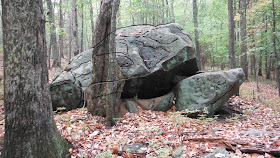(Formerly Mystery Hill, NH)
Plug the fanciful name into Google Earth and see what you get:
Lines of sight cut into the present day wounded forest.
(And please note I'm fooling with the various views you can get but messing with the buttons indicated by the red arrows:)
In fact, someone has made a scale model:
The scale model makes me wonder what it looked like, back before all the owners started messing around with it, re-building what was there way back before 1620 and especially before 1492, way back to the Late Archaic Period when Indigenous People were "hunting and gathering" - or actively shaping and maintaining a Cultural Landscape by using fire, depending on what source you might be reading.
So I’m looking for a close up of those stone rows, but everybody is more concerned about Phoenicians and Celts, sacrificial stones and moonshine...
The Hiking Meditators have this one, but I'm looking for some untouched segments:
Durned if I don’t find a few here:
"The Folklore of Alternative Archaeology" (presented to the
Archaeological Society of Connecticut, October 13, 2012) by Dr. Wade Tarzia, Associate Professor, Naugatuck Valley Community College
I found them among the arguments against the “folklore” alternatives
(excepting of course the “Yankee Farmer Folklore” that New England’s Stone Wall
Myths are based on) that ignored completely the possibility that Indigenous
People might have built anything larger than a hearth out of stone. I had to
dig into some other website and excavate some documents to find out why.
I’ll save you the
trouble and slap these quotes up:
“The Aboriginal School -- A small but growing group
of people rejects the diffusionist theories and favors the idea that Native
Americans built Mystery Hill (MH – the former name of the tourist attraction). There
certainly is some precedent for such behavior, since Indian sites in the south
west include some that are astronomically aligned (Cornell: 1981:168). The school must assume that the site was
constructed after 1200 BC, when cultivated plants are introduced into New
England (Dincauze: 1974:53) -- that is, when at least partial sedentism and the
rise of tribal life (thus increased opportunity for corporate architectural
projects) may begin to occur..."
{Corporate? Does he mean cooperative? As in “The cooperative effort to
build the stone fish weir or the clam garden?" or "The cooperative effort to build
the stone hunting drive?" Maybe…}
"Band
Society (pre-1000 A.D. Indians in New England): Bands of hunter-gatherer
consist of small groups of 10 to 25 individuals who usually stay no longer than
a week at any base camp before local depletion of edible wild plants and
animals forces them to move to new territories -- they grow little or no food
and are not able to remain sedentary for the long periods required for
architectural pursuits. In addition, the low population density of band society
generates lower levels of social stress relative to more complex societies,
with the result that hunter-gatherers need fewer, less complex rituals of
stress reduction. That is, ritual architecture may not have been requirements
for such people.”
In addition, the low population density of band society
generates lower levels of social stress relative to more complex societies,
with the result that hunter-gatherers need fewer, less complex rituals of
stress reduction. That is, ritual
architecture may not have been requirements for such people.
The
high degree of nomadism inherent in hunter gatherer life would not allow them
to remain in any one location long enough for extended architectural
endeavors. And if we acknowledge the
recent work of archaeologists like Renfrew (1984, 1984b), which suggests that
megalithic monuments functioned to support land-holding groups, then we must
reject a hunter gatherer basis for MH once again -- for hunter gatherers are
little concerned with land rights or ownership.
If we
are to believe the oldest held date for MH, then Indians would not have built
the site. Once Indian populations grew
large enough for them to require sedentism and agriculture -- and evolve into a
tribal social-system -- the date is around 1000 AD. If AmerIndians built MH, it must have origins
after this date; yet, this goes against the popularly acknowledged dates of the
site..." From:
http://www.wtarzia.com/files/Mystery_Hill_ms.rtf
Well, I'm just going to back up to that first photo of Dr. Wade's. I don't know where it is on that scale model of the site that reminds me so much of the rows of stones I see around me, not too far from Naugatuck Valley Community College - or in what was once known as the Old Deer Park that borders the College property. I think I see some suggestion of a possible petroform (or geoglyph) that is distinguished by a triangular shape that makes me think of a snake (and I'll overlay a couple Serpentine details):
2018 Update Overlay:
What might a "real archaeologist" say about this?
What might an "open minded real archaeologist" say about this?
Take a look here:
Follow the links found here:
I think I illustrate a few good examples of what might interest a "real archaeologist" of some possible places to conduct a test or two in order to test a theory that not every one of the quarter million miles of stone fences or walls are what we've been taught they are:
They even dug up this old map - wouldn't it be interesting to look at the "gateways" that appear to have some boulders incorporated into them?





























































